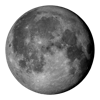Moon Phase on September 19, 1902: Waning Gibbous
On Friday, September 19, 1902 the Moon was in its
Image of the Moon Phase on September 19, 1902
The image below represents the phase of the Moon on September 19, 1902. The blue dots indicate prominent lunar features that were suited for observation under that day's illumination conditions. Scroll down to see the list of interesting lunar features visible on that day or click any blue dot to go directly to the feature details.
Credits: this image and other Moon images in this page are derived from public domain material from Lunar QuickMap.
Interesting Lunar Features Visible on September 19, 1902
The Waning Gibbous phase shows a decreasing but still significant portion of the lunar surface illuminated.
The terminator, currently at lunar longitude
The following is a list of the most prominent lunar features that are visible on September 19, 1902. The list is derived from the famous Sky & Telescope Lunar 100 list, contextualized to the visibility conditions of the Moon phase on that day. Scroll the list or click on one of the shortcuts below.
A Note about the Eastern and Western Sides of the Moon
This section sometimes mentions the Eastern or Western side (or limb) of the Moon. It is important to understand that these terms refer to Selenographic Coordinates, which are fixed directions on the lunar surface, analogous to longitude and latitude on Earth. Selenographic 0° longitude is roughly the line that cuts the Moon disc into two equal halves. Selenographic East is defined as the direction of increasing longitude, and Selenographic West is the direction of decreasing longitude, as shown in the following image:
This definition ensures that for an observer on the Moon, the Sun would appear to rise from the selenographic Eastern horizon and set towards the selenographic Western horizon.
From an Earth-based observer's perspective, this convention can be counter-intuitive: the Moon's selenographic Eastern limb is the edge that points towards West and the selenographic Western limb is the edge that points towards East. Another way to think about it is that the selenographic Eastern limb, when observed from Earth, is the limb that rises first, while the Western limb is the limb that sets last.
Additional Resources on TheSkyLive
- The Moon: Complete reference information on TheSkyLive.com.
- Today's Moon Phase: Current phase of the Moon, high-resolution image of its present appearance and list of visible features.
- Next Full Moon: Precise date, time and visibility information of the next Full Moon.
- Next New Moon: Precise date, time and additional information about the next New Moon.
- Moon Calendar: Track the phases of the moon for each day.
- Where is the Moon?: Key information on where to find the Moon in the sky.
- Distance of the Moon from Earth: Find out how far the Moon is from Earth right now.
- How Bright is the Moon?: Current visual brightness (magnitude) and apparent size.
- Rise and Set Times: Rise and set times of the Moon from your location.
- Interactive Sky Map: Planetarium-style interactive visualization of the Moon's position in the sky.
- Ephemeris: 15 days the Moon's computed ephemeris.
- Physical Data: Detailed information about physical properties of the Moon.
The Waning Gibbous Phase
The Moon is in its Waning Gibbous phase during the week following the Full Moon, as it progresses towards the Third, or Last, Quarter. During this phase, the illuminated portion of the Moon visible from Earth decreases each night, though it is still more than half lit.
Its angular distance from the Sun (measured eastward) continues to decrease from its
The ideal time to observe the Waning Gibbous Moon is during the late evening and for much of the night. It rises after sunset and sets after sunrise, often visible in the daylight sky during the morning.
Close










